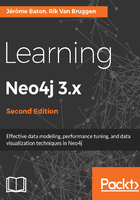
Large set-oriented queries
If you think back to what we discussed earlier and think about how graph databases achieve the performance that they do in complex queries, it will immediately follow that there are a number of cases where graph databases will still work, but not be as efficient. If you are trying to put together large lists of things effectively sets, that do not require a lot of joining or require a lot of aggregation (summing, counting, averaging, and so on) on these sets, then the performance of the graph database compared to other database management systems will be not as favorable. It is clear that a graph database will be able to perform these operations, but the performance advantage will be smaller, or perhaps even negative. Set-oriented databases such as relational database management systems will most likely give just as, or even more, performance.